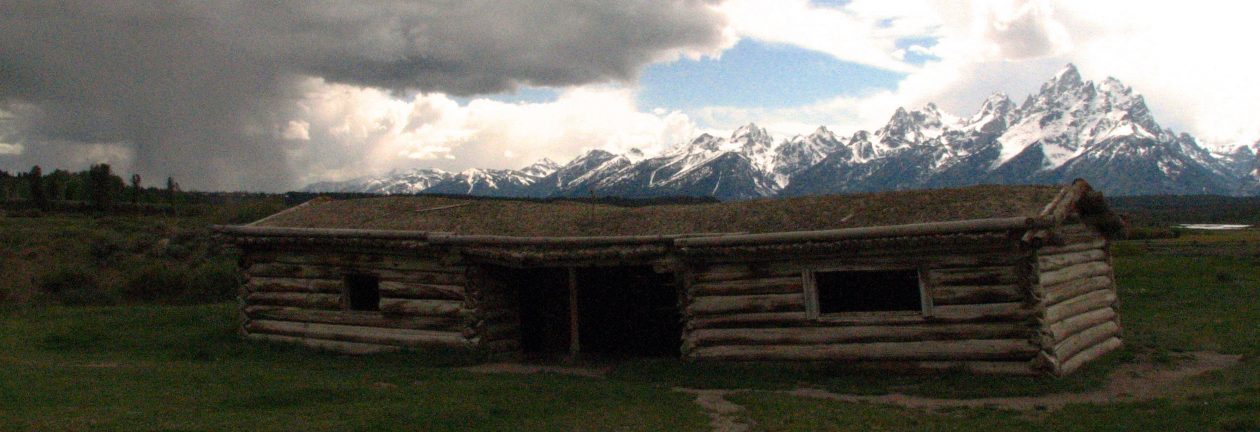Kanchanaburi, Thailand
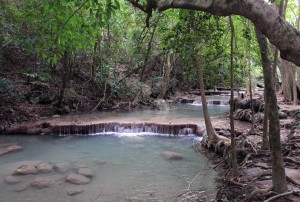
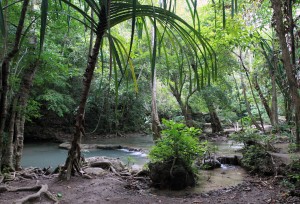
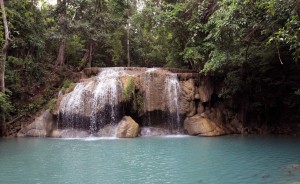
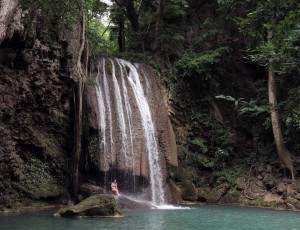
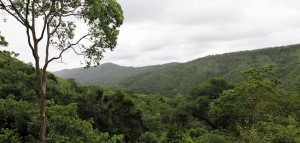
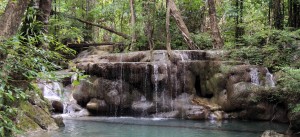
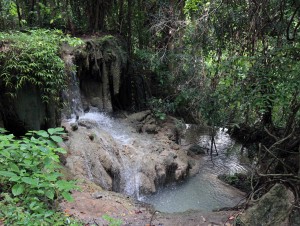
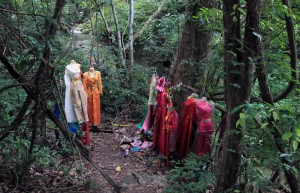
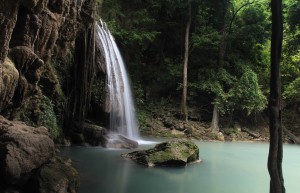
I woke up today and got ready to see Erawan Falls. Just as happened yesterday, the guesthouse arranged a free motorbike ride to the bus station and directed me to the correct bus to take – which had just departed, so the motorbike driver chased after, caught up, and I had gotten on; the bus was full of Western tourists, so there was no doubt in my mind that this was indeed the correct bus. It drove north for almost two hours before arriving at the national park; the passengers all paid the entrance fee (200 baht for foreigners) and then the bus dropped us off at the Visitor Center; I got off, had a quick snack and drank some ice cold tea for liquids and energy before hiking to the many waterfalls. Erawan Falls has seven tiers of waterfalls, so I decided to hike up to the seventh tier (over 1,600 meters through beautiful jungle) to see each tier before deciding on which tier I would bathe in. The trail wasn’t too difficult and each tier of the waterfalls each had its own particular beauty (at some points along the trail there were signs of where the stream once flowed and there were several miniature caverns – not much more than an arm’s length); at one point the trail went right in to the stream and all the other hikers and I had to hop across slippery rocks to continue on. The topmost tier had several people climbing up on the rocks and trying to slide down, but they mostly just pushed themselves down the slope; it then began to rain while I was at the top, so I decided to take cover under the jungle canopy and travel back down to the third tier, which I determined was the most beautiful – it had the tallest waterfall and many bathers had climbed up behind it, in its cavern. So I descended back down along the trail until reaching the third tier, where I disrobed down to my swimming trunks and walked in to the water; the first thing I noticed was how cold the water was (at least compared to the ambient air temperature) and the second thing I noticed was that many fish had gravitated to me to nibble on the dead skin on my legs (it was ticklish and awkward). I then swam to and around the falls for a solid twenty minutes before coming back out to check the time – it was 13:15 and I would have to soon be on my way to catch the bus scheduled to depart the park at 14:00. I then used my variable neutral density filter on my camera to take some last minute photographs of the falls before putting my clothes back on and hiking back to the bus stop. I then boarded the 14:00 bus back to Kanchanaburi.
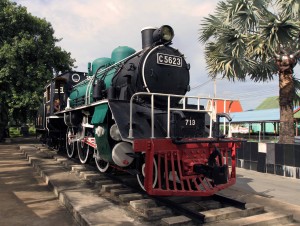
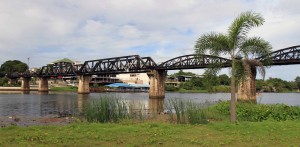
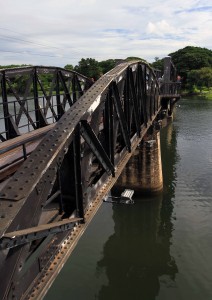
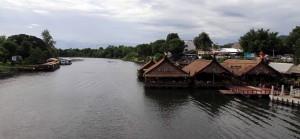
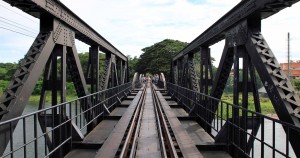
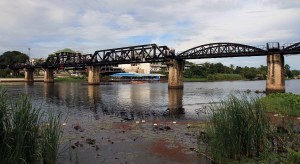
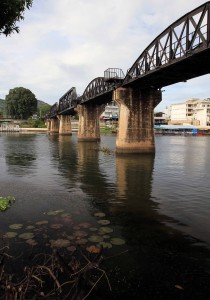
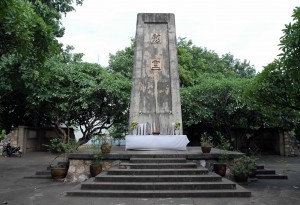
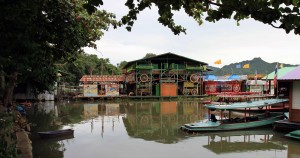
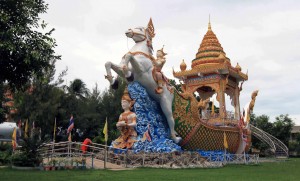
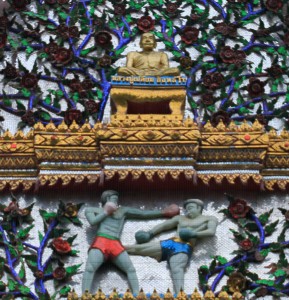
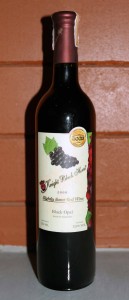
As the bus passed by the famous bridge on the Kwae Yai River, I told the driver to stop and I got out. I then walked to the bridge. When Peter Boulle wrote his famous novel, ‘The Bridge on the River Kwai’, he knew the Thai-Burma Railway ran parallel to the Kwae River for many kilometers and he assumed that it crossed the Kwae at some point; this, however, was not the case, the “Death Railway” crossed the Mae Khlung River; so when tourists came to Thailand to see the famous site that inspired the novel and later the masterpiece film by David Lean, they were rather disappointed, but Thailand (realizing the monetary potential from these tourists) changed the name of the river from Mae Khlung to Kwae Yai (“Big Kwae”) in 1960, thus making the still-standing railway bridge cross the River Kwae instead of the Mae Khlung. Originally, there was a wooden bridge which crossed the river (just like in the novel and film), but a few months later, the current concrete and steel bridge was built (both were built in 1943) and the wooden bridge was destroyed; so all the tourists come to see the concrete and steel “Bridge on the River Kwai” (a very different-looking bridge than we’ve seen in the 1957 Best Picture film – it is also worth noting that the 1957 film was actually filmed in Sri Lanka . . . it is furthermore worth noting that the greatest film ever made had several scenes filmed on the River Kwae (standing in for Vietnam) – though I’m not sure exactly where). I passed by the railway station near the bridge which had two steam engines on display before I walked across the bridge to the other side. At the opposite bank of the river, I walked down to a garden and took many photographs of the bridge; then I walked back up to the railroad tracks and crossed the bridge again. I then headed south, back to the city center of Kanchanaburi, passing by a museum with an old Japanese steam engine which was used to haul supplies on the “Death Railway” during the war. I then passed by a grocery store where I bought a bottle of wine produced in Thailand for consumption later tonight. I then realized I didn’t have a corkscrew and therefore stopped at many stores along the way back to the guesthouse to ask if they had one for sale – one store did have a corkscrew, but it was a wing corkscrew (too big for my tastes) and I was looking for a sommelier knife instead. So, disappointed in my search for a decent corkscrew, I continued on back to the guesthouse, passing by a monastery with an ornate temple designed to look like a boat and with one building’s facade decorated with a relief of Muay Thai boxers kicking the shit out of each other (the resident monks at this temple must be pretty cool dudes). I then found a place to eat a quick and cheap dinner – McDonalds – where I had a Samurai pork burger and fries. I then walked back to the guesthouse in drizzling rain and, luckily, they did have a corkscrew; so I was able to drink my bottle of “Black Opal, slightly sweet red wine” – it tasted like blackberry and raspberry jam; it was drinkable, but not complex and overall disappointing; hopefully I will have much better Thai wine in my near future. Then, I typed out some journal entries, watched some television, and finally went to sleep – all while drinking my wine. Hooray for life!
